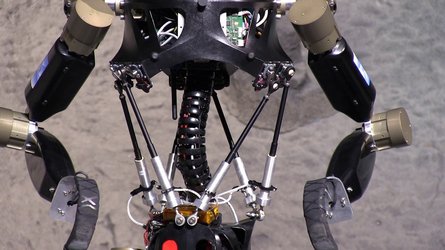VIPE
Exploration in terrain difficult to access (e.g. Valles Marineris) using visual and proprioceptive data.

The DLR Space Administration started the Initiative "VaMEx - Valles Marineris Explorer" with the aim to explore craters on Mars up to 7 km deep fully autonomous by a heterogeneous swarm of robots. This environment appears due to the earlier volcanic activity as well as the references to water resources extremely promising for a variety of scientific issues. To have a comprehensive picture of Valles Marineris and thus potential niches for extraterrestrial life, areas which are difficult to access have to be included in the exploration in particular. Utilizing a hominid robot platform and novel approaches for fully autonomous positioning, mapping and navigation will help to meet and to deal with the environmental conditions.
| Duration: | 01.05.2015 till 30.06.2018 |
| Donee: | German Research Center for Artificial Intelligence GmbH |
| Sponsor: |
Federal Ministry for Economic Affairs and Climate Action
German Aerospace Center e.V. |
| Grant number: | This project is funded by the Space Agency of the German Aerospace Center with federal funds of the Federal Ministry for Economic Affairs and Climate Action (BMWi) in accordance with the parliamentary resolution of the German Parliament, grant no. 50NA1516. |
| Website: | http://www.vamex-vipe.de/ |
| Partner: | Technische Universität München (TUM) NavVis GmbH |
| Application Field: | Space Robotics |
| Related Projects: |
iStruct
Intelligent Structures for Mobile Robots
(05.2010-
08.2013)
iMoby
Intelligent Mobility
(04.2009-
06.2012)
|
| Related Software: |
Bagel
Biologically inspired Graph-Based Language
|
Project details
The Valles Marineris, a jagged rift valley, places high demands on robotic exploration mission. Within the VaMEx 1 project, the swarm of heterogeneous robots (rovers and aerial robots) already allowed a significant application expansion of the exploration mission. Still, caves, steep slopes, and rugged rock formations continue to be a major challenge for the use of mobile robots and for the autonomous navigation. The aim of this project is to fill this gap within the robotic swarm and to increase the navigation abilities. To achieve this efficiently and economically, available expertise and hardware that has been established in previous projects as well as synergies with parallel running projects will be exploited. The hominid robot "Charlie" (developed within the "iStruct" project) will expand the robotic team. This is due to its lightweight and highly integrated design, its agility, and integrated tactile sensors ideally suited to deal with difficult terrain. Furthermore, a novel visual positioning and mapping approach will be developed, featuring a 360° panoramic camera which allows a positioning with very low drift despite the above-mentioned, demanding conditions. This visual positioning is to be supplemented by a complementary proprioceptive approach based on tactile sensors to improve self-localization. This is a prerequisite for movement planning and reactive motion control to allow the robot to overcome obstacles autonomously. By combining the created maps via higher-level network intelligence, a fully autonomous navigation even in difficult terrain will be possible. The technologies to be explored in this project have the potential to be beneficial also for terrestrial applications such as people navigation, service robotics, cave exploration, or search and rescue missions (Fukushima, earthquake zones, etc.). Therefore, however, additional requirements have to be considered. So, a further objective of this project is to explore needed extensions of the developed key technologies to make them usable for terrestrial applications.




